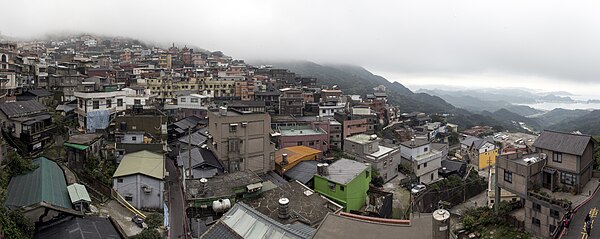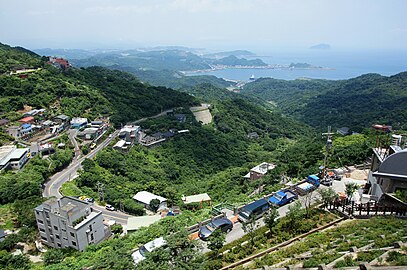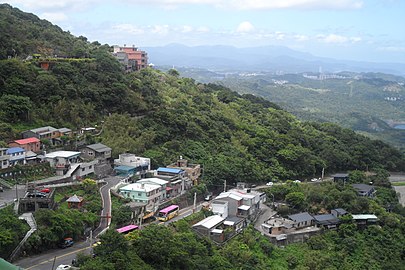Jiufen

| Jiufen | |
|---|---|
Hanyu Pinyin | Jiǔfèn |
| Wade–Giles | Chiu3-fen4 |
| Tongyong Pinyin | Jiǒufèn |
| Southern Min | |
| Hokkien POJ | Káu-hūn-á |
Jiufen, also spelled Jioufen or Chiufen (Chinese: 九份; Hanyu Pinyin: Jiǔfèn; Tongyong Pinyin: Jioǔfèn; Wade–Giles: Chiu3-fen4; Pe̍h-ōe-jī: Káu-hūn-á; lit. 'nine portions'), is a seaside mountain area in Ruifang District, New Taipei City, Taiwan.
Jiufen Old Street is a narrow, winding alleyway with shops, teahouses, and restaurants that offers tourists a view of traditional Taiwanese life.
History
During the first years of the
Despite the earliest reference to the production of gold in the island dating to 1430,[1] and multiple rediscoveries by early inhabitants, visiting Japanese, Dutch occupiers, and Koxinga's retainers, awareness of the wealth of Taiwan's gold districts did not develop until the late Qing era. In 1890, workmen discovered flakes of gold while constructing the new Taipei-Keelung railway,[2] and in 1893 a rich placer district was discovered in the hills of Kau-hun that produced several kilograms[a] of gold a day. In the next year, the promise became greater than ever after a Chinese "expert" with experience gained in California found gold-bearing quartz in the said hills.
The resulting gold rush hastened the village's development into a town, and reached its peak during the Japanese era. In The Island of Formosa, Past and Present (1903), American diplomat James W. Davidson wrote, "Kyu-fun [Kau-hun] is as odd looking a settlement as one could find. [...] never before has the writer seen so many houses in such a small space. Some appear to be partially telescoped in adjoining buildings, other standing above as though unable to force their way to the group, and each structure seems to be making a silent appeal to its neighbor to move over."[4] Water ran "in many small streams, directed so as to provide each building with a little rivulet, passing sometimes by the doorway or even over the floor of the building." The claim was owned by the Fujita Company, the first Japanese company to mine quartz in Taiwan and which occasionally made an income of a few thousand yen per month from the Kau-hun gold operations.
Many present features of Jiufen reflect the era under Japanese colonization, with many Japanese inns surviving to this day. During
In 1989,
Jiufen also became popular in 2001 due to its resemblance to the downtown in the Japanese anime movie Spirited Away by Studio Ghibli.[5] Jiufen soon attracted Japanese tourists. Many Japanese travel magazines and guide books about Taiwan introduced Jiufen. It became a must visit place among Japanese tourists. However, Miyazaki himself denied that Jiufen was the model city of the movie.[6] [7]
At present, Jiufen is a renowned tourist attraction representative of Taiwan. It draws many tourists from Taipei during the weekends.


Gallery
-
Panoramic view from the balcony table of a teahouse
-
Jiufen at night
-
Jiufen, Taiwan
-
Jiufen at night
-
Jiufen, Taiwan
-
Jiufen Mountain View
-
Traditional Architecture
-
Shengping Theater
-
Jiufen Mountain View
-
Nightview of Jiufen from Mt. Keelung
-
A vibrant painting of gold miners on a hillside
Transportation
- As Jiufen is a mountain town, the roads that lead there are mostly steep, curving, narrow, and possibly dangerous.
- The town is served by buses that run from Keelung, Taipei, etc.
- The nearest train station is Yilan Line, which is 15 minutes away by bus.
Foods


- A-Zhu Peanut Ice Cream Roll
- Ah Gan Taro Balls
- A-Mei Tea House
- Wu Di ‘Flower Lady’ Taiwanese Sausages
- Zhang Ji Traditional Fish Balls
- Ah Lan Glutinous Rice Cake
See also
Notes
- ^ Converted from original quote, "several thousand yen worth of gold",[3] using the 1871 legal definition of the Japanese yen as 1.5 g of pure gold (worth approximately one dollar at the time).
References
- ^ Davidson (1903), p. 462.
- ^ Davidson (1903), p. 464.
- ^ Davidson (1903), p. 465.
- ^ Davidson (1903), p. 469.
- ^ "Jiufen: The Real Life Spirited Away". Tofugu. October 1, 2013.
- ^ 【FOCUS新聞】TVBS專訪宮崎駿 72歲不老頑童(3分頃から)。
- ^ 台湾の九份は「千と千尋の神隠し」のモデル地ではない
Bibliography
- This article uses translated material from the equivalent Japanese-language Wikipedia article (retrieved 26 February 2006). Both articles are licensed under the GNU Free Documentation License.
- OL 6931635M.












